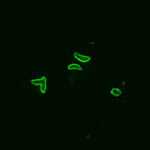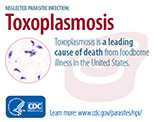Diagnosis

A Toxoplasma-positive reaction, stained by immunofluroescence (IFA). (CDC Photo)
The diagnosis of toxoplasmosis is typically made by serologic testing. A test that measures immunoglobulin G (IgG) is used to determine if a person has been infected. If it is necessary to try to estimate the time of infection, which is of particular importance for pregnant women, a test which measures immunoglobulin M (IgM) is also used along with other tests such as an avidity test.
Diagnosis can be made by direct observation of the parasite in stained tissue sections, cerebrospinal fluid (CSF), or other biopsy material. These techniques are used less frequently because of the difficulty of obtaining these specimens.
Parasites can also be isolated from blood or other body fluids (for example, CSF) but this process can be difficult and requires considerable time.
Molecular techniques that can detect the parasite's DNA in the amniotic fluid can be useful in cases of possible mother-to-child (congenital) transmission.
Ocular disease is diagnosed based on the appearance of the lesions in the eye, symptoms, course of disease, and often serologic testing.
- Page last reviewed: November 17, 2016
- Page last updated: November 28, 2016
- Content source:



 ShareCompartir
ShareCompartir